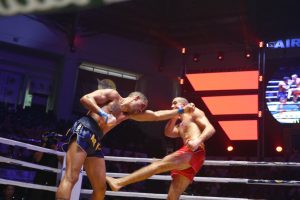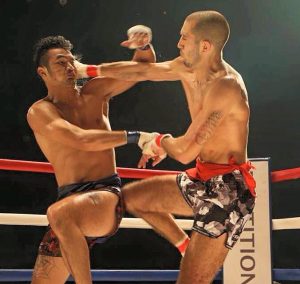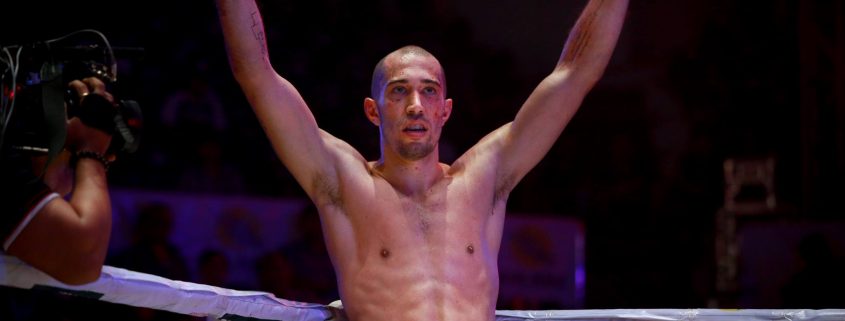Dave Leduc Reach
You often hear commentators and fight analysts talk about Dave leduc reach, and his various skill sets.
Things like speed, timing and flow are skills that can be gained and improved with training.
Then we have some physical attributes like height and reach which we are born with and martial artist and combatants need to learn to use to their advantage.
Reach is one of the physical traits that people tend to bring up when talking about Lethwei World Champion Dave Leduc.
Many will quickly point to reach to be his main advantage, sometimes focusing way to much on it and missing many other skills in his arsenal. Dave does have a « good reach » with his arms at 78″ and long legs to go with his 6’2 frame. He weighs normally only between 178 and 185 pounds making him tall and lanky but not heavy framed.
My experience as a martial artist , coach and fighter has taught me that reach by itself is NOT the huge factor many people make it out to be.
Fighters like Jon Jones, (MMA) and Semmy Shilt, ( K1) are examples of fighters using their reach and long limbs to their advantage.
Hitting their opponents with clean hard shots while staying out of harms way. This skill requires more than just having longer limbs: proper timing, reflexes and accuracy are keys to using your reach along with understanding DISTANCE with your opponent with good judgment and footwork.
This is a skill that Dave drills , trains and uses effectively in combat.

Examples of range
Dave using a low side kick to « jam » 6’3 French kickboxer Correntin Jallon
Dave leduc reach can be explained as a combination of using distance, your range (whatever it may be) and the right « weapons/tools) to use in the range you and your opponent are in. Just like a soldier who will use a knife at close range for taking out a sentry and a sniper rifle for a long range kill , combat athletes must learn to use the best tools at the right range to inflict the most damage and be efficient.
Shorter fighters can use an opponents reach against them by » closing » the distance and » crowding » the taller fighters, making the use of long limbs awkward and tied up.
Fighters like Mike Tyson, K1 fighters Robin Van Roosmalen and Mike Zambidis come to mind . They are often shorter but have mastered how to get into their optimal distance and range to be effective.

Close range examples
Close range exchange with Sudsakorn in Japan
Lethwei destroyer Tun Tun Min vs Nicolas Carter is a good example of a tall fighter having a hard time using his reach. Carter is a British muay Thai Champion, that has fought in Thai fights and the prestigious Lumpini stadium. Standing 6’3 and lanky he was yet unable to keep the hard charging, powerful Tun Tun Min from getting in range and was overtaken quite easily with vicious punches, headbutts and low kicks.
This fight was after Tun Tun min lost to Dave Leduc in Myanmar in their trilogy fight. Dave unlike Nicolas was able to intercept and keep Tun Tun Min on the end of his reach, and he was also able to adapt to the range when his powerful opponent was able to close the distance and make it to infighting range. where he inflicted damage and went toe to toe inside with TTM.
I made Dave aware at a early stage of his development that opponents where going to get inside and make him uncomfortable and try to bully him.
He worked hard at using short range weapons such as elbows, knees and headbutts, weapons best used at that range. Dave actually has most of his ko’s at close range and has built dangerous and varied in fighting attacks to complement the proper use of his reach.
He demonstrated this by dominating both shorter and opponents taller/ bigger than him like European Muay Thai champ Correntin Jallon ( 6’3 , 90kg) and UFC veteran Seth Baczynsky (6’3, 205 pounds).

Punching range
A young Dave Leduc using his jab vs a thai fighter with 60+ fights at « Prison Fights » in 2014
Tall and lanky with a 78′ reach or the unique 84″ of a Jon Jones , or a 71″ short and stocky of a Mike Tyson , good martial artist and fighters must learn to properly understand how to land their weapons and the right use of footwork (distance) and tools (range).
A good understanding of which tactics gives them the advantage ( outside or inside) and be able to adapt quickly to the fast changing and unpredictable nature of fighting. The proper use of your body type and building skills that fit you is key!
Train with various size partners, tests various tactics, understand how to use your reach to the fullest and how to fight at all ranges.
Stay open minded and ready to learn at all times! There is no « magic’ moves or unbeatable style.



